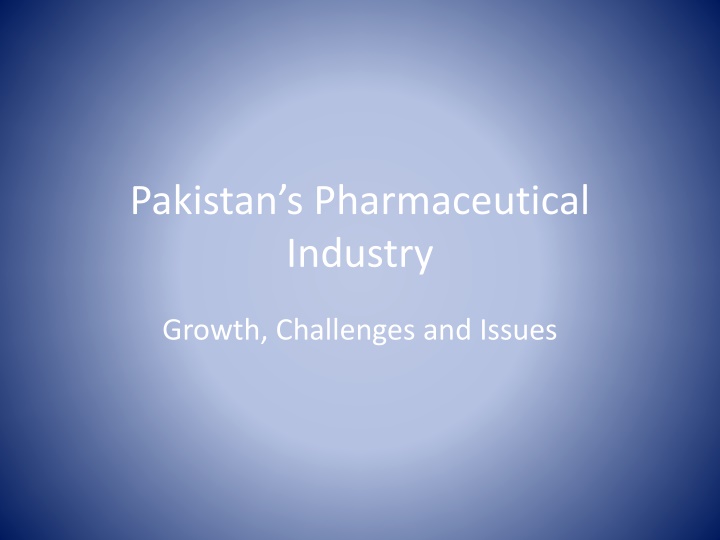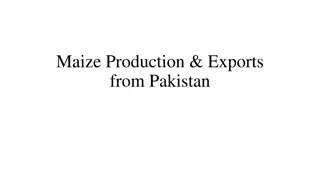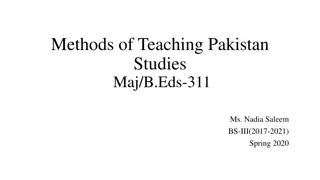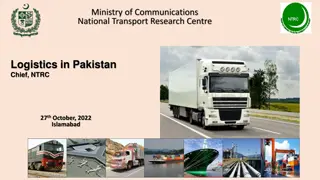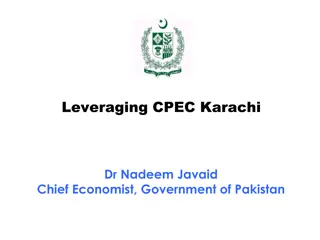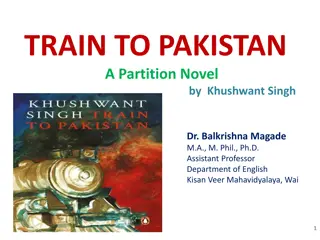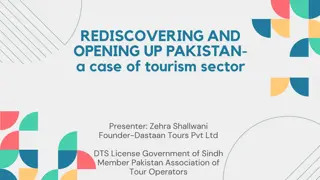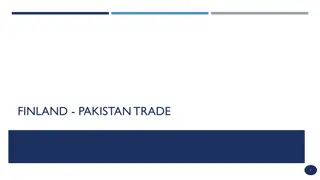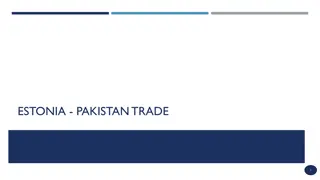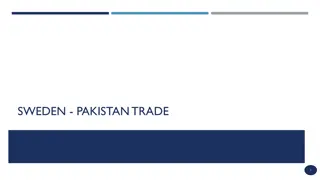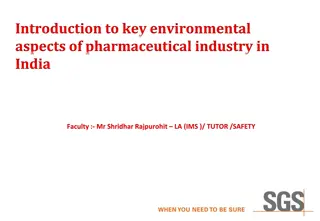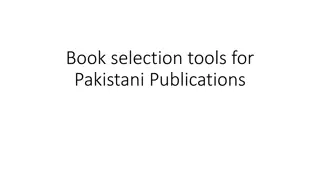Overview of Pakistan's Pharmaceutical Industry: Growth, Challenges, and Issues
Pakistan's pharmaceutical industry faces growth challenges such as heavy government regulation, pricing issues, and reliance on imported raw materials. Despite a respectable growth rate, the sector has not reached its potential. The market is dominated by a few firms, with a significant portion of products being imported. Government control extends from initial registration to final pricing decisions, impacting market dynamics and innovation.
Download Presentation

Please find below an Image/Link to download the presentation.
The content on the website is provided AS IS for your information and personal use only. It may not be sold, licensed, or shared on other websites without obtaining consent from the author.If you encounter any issues during the download, it is possible that the publisher has removed the file from their server.
You are allowed to download the files provided on this website for personal or commercial use, subject to the condition that they are used lawfully. All files are the property of their respective owners.
The content on the website is provided AS IS for your information and personal use only. It may not be sold, licensed, or shared on other websites without obtaining consent from the author.
E N D
Presentation Transcript
Pakistans Pharmaceutical Industry Growth, Challenges and Issues
Basic Information 750 firms, but Government s regulatory authority puts the number at 639 (geotagged) Estimated size is $3.1 billion or a bit more, not even 0.3% of the global volume (which is more than $1.1 trillion) In terms of product sales, highly skewed structure: top 100 firms have 95 percent of the market share (top 50 firms having a share of 89 percent). Remaining 650 firms 5 percent Out of the total sales, 80 percent products manufactured in Pakistan while 20 percent imported
Exports in 2018-19= $211 million. Indias pharmaceutical exports were $19.6 billion in the same year The industry employs 150,000 individuals directly, and 300,000 people indirectly
95 percent of the raw material and Active Pharmaceutical Ingredients (APIs) for manufacturing are imported, from China and India MNCs produce patent or originator brand medicines, while domestic firms produce generics (cheaper versions of originator brands) MNCs used to have around 60 percent of the market share. Now, their market share is hardly 40 percent. Domestic pharma companies now have a 60 percent share FDI Negligible. In 2018-19, it was approximately $26 million. FDI in Indian pharma industry approximately $26 billion at the same time Drug Regulatory Authority of Pakistan (DRAP) main regulator
Issues plaguing growth of the sector Although the Compound Annual Growth Rate (CAGR) of Pak pharma industry stood at a respectable 12% in last 5 years, it does not mean that the industry does not face any issues and is in a healthy state In fact, it has performed below its potential for long Main reason: heavy government regulation. No industry in Pakistan is as heavily regulated in Pakistan as pharmaceutical industry, with initial registration to final retail price, all decided by government
Pricing- The most contentious issue No concept of market forces determining prices. DRAP finalizes the sale price, which has to be approved by the cabinet. Thus, pricing is a political decision The most notable instance: complete prize freeze on medicine prices from 2001 to 2013. Prices of only few medicines allowed to increase ( hardship cases), while most remained the same for all these 12 years In the same time, cost of production increased manifold
Pricing- The most contentious issue Two new pricing policies- 2015 and 2018, the latter implemented after Supreme Court s order in a case involving price increase of medicines The 2018 policy uses reference pricing, and allows increase relative to CPI (cap of 7% for essential medicines and 10 percent for all others) For industry, 2018 policy much better option compared to prize freeze type policies However, no smooth sailing under this policy too. A special audit, in lieu of controversy surrounding granting price increases in 2019, claimed to find several anomalies in pricing methodology All this means is that the saga surrounding pricing medicines has not abated, and we will see more litigation in the future
The fallout from administered pricing Out of the approximately 70,000 registered medicines, hardly 10,000 being produced: it became financially unfeasible to produce many medicines b/c cost>retail price due to administered price policies Drug shortages, especially of life saving medicines, became more pervasive Many medicines, previously produced domestically, had to be imported, sold at three times or more No significant FDI coming in Prize policies was main reason many MNCs left the country or divesting away from manufacturing medicines Producers turning to other methods to escape the fallout, like registering medicines under alternate or nutraceuticals category, with relatively deregulated prices
Other issues confronting the industry Toll or contract manufacturing- It s a global practice, which helps utilization of underutilized capacity in pharmaceutical sector. Contract manufacturing in India worth $36 billion, creating jobs and bringing in FDI. However, for unexplained reason, Pakistani regulators have remained averse to the idea of contract manufacturing Issues related to registration time of drugs (too long, complain the industry). Cases from 2014 still pending for approval by regulator Official policies leading to loss of nearby markets like Pakistan No IP protection. That s a disincentive for research Lack of quality infrastructure and research, for which government has been charging a tax since 1976 Lack of quality human capital
Regulator DRAP, founded in 2013, after deaths at Punjab cardiovascular institute due to sub-standard medicines Formerly, the industry was regulated under the 1976 Act Three main boards ( Policy Board , Licensing Board and Registration Board ). There are 14 sub-divisions, tasked with carrying out the work and directions of DRAP Compared to pre-DRAP, post-DRAP regulator performance has been termed comparatively satisfactory by analysts However, significant challenges remain
DRAP performance- Challenges Limited resources, both monetary and qualified human capital. A total of 26 drug inspectors for the whole country Although the prevalence of sub-standard or poor quality medicines is greatly exaggerated, failure to control continued recurrence of sub-standard or ineffective medicine instances Provision of quality infrastructure- Not a single FDA approved laboratory in Pakistan, which is the global gold standard in pharmaceutical industry Non-explanation of all the money collected under Central research Fund (CSR) since 1976. Where did all the money go, where was it spent, how much in total collected from pharmaceutical companies since 1976, etc.?
DRAP performance- Challenges Continued failure to ensure availability of essential, life-saving medicines. Hardly 15 percent of essential medicines are available at public institutions, while 30 percent are available in the private sector (retail, private hospitals, etc.). Failure to stop deceptive marketing practices, doctor- producer collusion, and over-subscription of medicines by doctors. These not only lead to additional out-of-pocket expenditures, but also pose health risks as increased use of medicines leads to higher resistance against medicines. Failure to stop selling of generic drugs as branded generics , which is price differentiation tactic, costing the consumer more. Shortcomings in ensuring qualified pharmacists dispensing medicines at medical stores
Public perception of the industry Overall, negative Chief Justice (CJ) has termed the industry as a mafia during a recent court hearing Print media s presentation of the industry heavily tilted on the negative side A minor price increase of Rs. 5, for e-g, is always presented in percentages to garner public anger Media never mentions that many pharmaceutical firms run charitable intitiatives, and that the industry is one of the top taxpayers in the country
